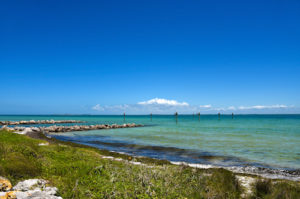The National Estuary Program (NEP) is a “collaborative, effective, efficient and adaptable coastal ecosystem based network” established by the Environmental Protection Agency (EPA). That is a lot of words. The basic description: the NEP is dedicated to keeping coastal estuaries healthy and beautiful, both nationally and here in Florida.
What is an Estuary?
 The first thing you should know is what an estuary is. An estuary is a partially enclosed, coastal body of water where fresh water from creeks, rivers, and streams empties into the ocean’s salt water. They are found off of most coasts that have some sort of land protection: an inlet, a bay or rock outcropping. They are uniquely affected by tidal activity while also being shielded from the ocean’s full erosive force.
The first thing you should know is what an estuary is. An estuary is a partially enclosed, coastal body of water where fresh water from creeks, rivers, and streams empties into the ocean’s salt water. They are found off of most coasts that have some sort of land protection: an inlet, a bay or rock outcropping. They are uniquely affected by tidal activity while also being shielded from the ocean’s full erosive force.
Estuary Ecosystem
An estuary’s ecosystem has some of the most diverse organic matter in the world. In fact, compared to similarly sized ecosystems of forestland and agricultural land, an estuary has more unique animals and plants. These varying ecosystems include:
- fresh and saltwater marshes
- swamps
- sand beaches
- mud and sand flats
- rocky shores
- oyster reefs
- mangrove forests
- river deltas
- tidal pools
- seagrass beds
With this much activity and life, the health of the area is of the utmost importance—and not just for the animals and plants, but for our economy and land protection as well.
In 2009, coastal estuaries created $7.9 trillion in revenue from tourism, fisheries, and recreational fishing. In addition, estuaries act as a buffer for both the ocean and the land. They work to filter our sediment and pollutants before the water recedes into the ocean while also protecting the shoreline from floodwaters and storm surges.
What Threatens Estuaries?
The simple answer: people. Coastal communities are continuing to grow at a rate rarely seen in other communities. This means more people and more impact on an already fragile ecosystem. While there are many different harmful factors, the main offenders include:
- fertilizers and pet waste in streams and rivers
- sediment from construction
- change in coastal landscapes and shorelines
- runoff from impervious surfaces like roads and parking lots
- wastewater from industrial sites
- untreated sewage from failed septic systems
What Can Floridians Do To Help Estuaries?
The National Estuary Program is especially important in Florida. With over 1260 miles of coastline, more than any other state in the continental United States, we have a lot to protect.
Being kind to our environment doesn’t have to be hard. The first and one of the easiest things you can do is to respect your septic system. This includes avoiding flushing products that do not belong in your system: chemicals, feminine products, flushable wipes, etc.
In addition, regular maintenance and inspections are required to keep septic systems healthy and efficient. To schedule a septic inspection, give Advanced Septic Systems in Clermont, FL a call at 352.242.6100.
Other simple changes include proper disposal of household products like grease, motor oil and cleaning chemicals. Reduce your use of fertilizers and pesticides in your yard. Keep recreational boats away from sensitive coastal areas like oyster and seagrass fields. Use reusable products when possible like sponges over wipes and reusable shopping bags.
Estuaries are an important part of our ecosystem. Not only do they house unique plants and animals, they are a revenue-driver and protectant for both the ocean and coastlines. Protecting them doesn’t have to be difficult and can be as easy as maintaining your septic systems and being careful with trash disposal.

